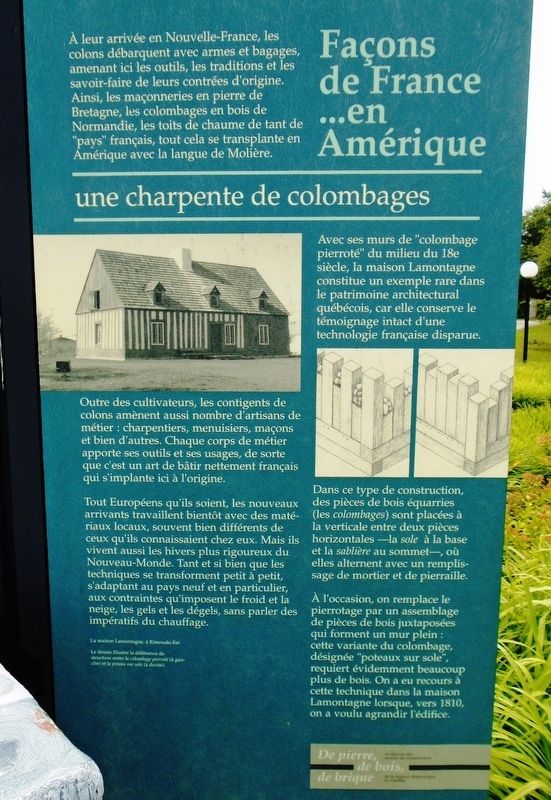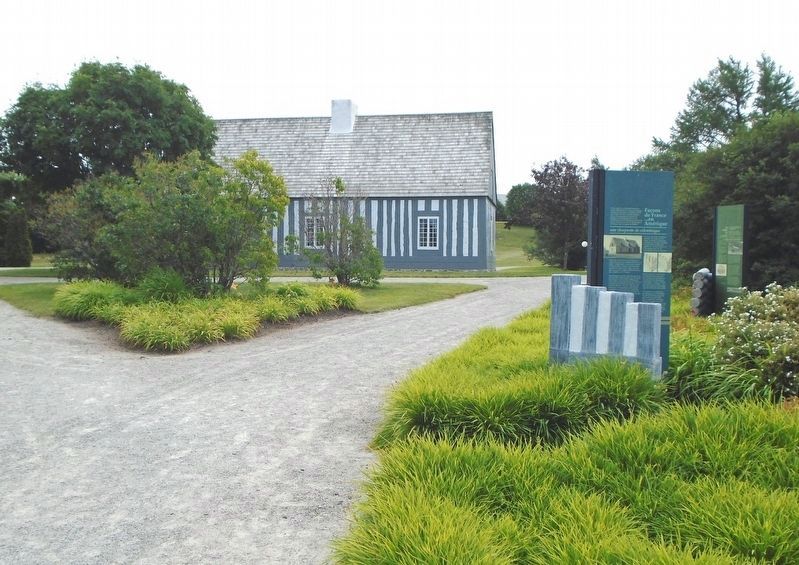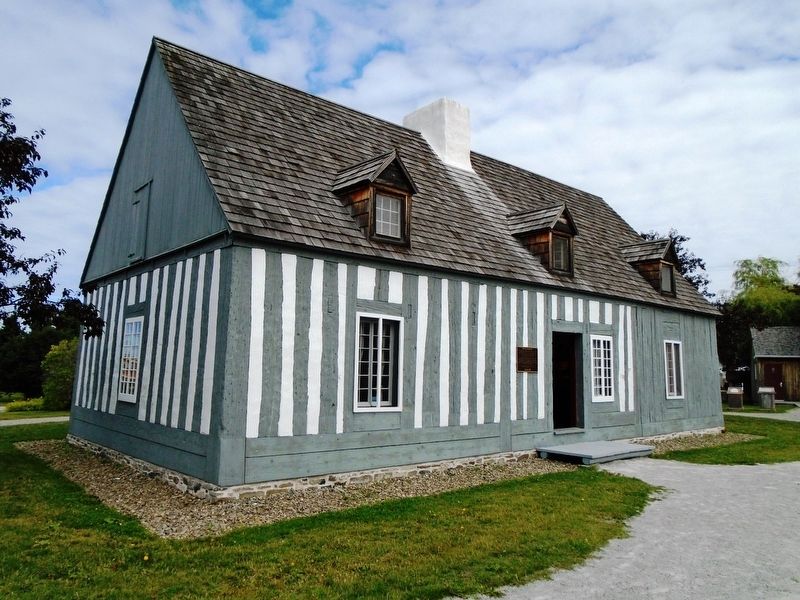Rimouski in Rimouski-Neigette, Québec — Central Canada (French-Canadian)
Façons de France ...en Amérique / French Ways ...in America
une charpente de colombages / a half-timbered frame
— De pierre, de bois, de brique / Stone, Wood, Brick —
Inscription.
À leur arrivée en Nouvelle-France, les colons débarquent avec armes et bagages, amenant ici les outils, les traditions et les savoir-faire de leurs contrées d'origine. Ainsi, les maçonneries en pierre de Bretagne, les colombages en bois de Normandie, les toits de chaume de tant de "pays" français, tout cela se transplante en Amérique avec la langue de Molière.
Outre des cultivateurs, les contigents de colons amènent aussi nombre d'artisans de métier : charpentiers, menuisiers, maçons et bien d'autres. Chaque corps de métier apporte ses outils et ses usages, de sorte que c'est un art de bâtir nettement français qui s'implante ici à l'origine.
Tout Européens qu'ils soient, les nouveaux arrivants travaillent bientôt avec des matériaux locaux, souvent bien différents de ceux qu'ils connaissaient chez eux. Mais ils vivent aussi les hivers plus rigoureux du Nouveau-Monde. Tant et si bien que les techniques se transforment petit à petit, s'adaptant au pays neuf et en particulier, aux contraintes qu'imposent le froid et la neige, les gels et les dégels, sans parler des impératifs du chauffage.
Avec ses murs de "colombage pierroté" du milieu du 18e siècle, la maison Lamontagne constitue un exemple rare dans le patrimoine architectural québécois, car elle conserve le témoignage intact d'une technologie française disparue.
Dans ce type de construction, des pièces de bois équarries (les colombages) sont placées à la verticale entre deux pièces horizontales —la sole à la base et la sablière au sommet—, où elles alternent avec un remplissage de mortier et de pierraille.
À l'occasion, on remplace le pierrotage par un assemblage de pièces de bois juxtaposées qui forment un mur plein : cette variante du colombage, désignée "poteaux sur sole", requiert évidemment beaucoup plus de bois. On a eu recours à cette technique dans la maison Lamontagne lorsque, vers 1810, on a voulu agrandir l'édifice.
[Légendes des illustrations lues]
La maison Lamontagne, à Rimouski-Est.
Le dessin illustre la différence de structure entre le colombage pierroté (à gauche) et le poteau sur sole (à droite).
On their arrival in New France, the settlers arrived with arms and luggage, bringing the tools, the traditions, and the know-how of their homeland. Thus, stone masonry from Brittany, timber stud construction from Normandy, the thatched roofs of so many French "homes,"
all this was transplanted to America with the language of [noted French playwright] Molière.
In addition to farmers, contingents of settlers included many craftsmen: carpenters, joiners, masons and others. Each craft group brought its tools; their use demonstrated that it was clearly the French art of construction that was implanted here from the beginning.
The newcomer Europeans worked with local materials that often were very different from those they knew at home. But they also lived in harsher New World winters, so much so that their building techniques gradually changed to adapt to the new country and, in particular, to the constraints imposed by cold and snow, freezing and thawing, not to mention the heating requirements.
With its half-timbered walls dating back to the mid-18th century, Lamontagne House is a rare example in Quebec's architectural heritage as it preserves the intact testimony of a French technology that has disappeared.
In this type of construction, squared pieces of wood (half-timbering) are placed vertically between two horizontal pieces -the base and the base at the top-where they alternate with a filling of mortar and rubble.
Occasionally, the pierrotage was replaced by an assembly of juxtaposed pieces of wood that form a solid wall: this stud variant, called "posts on sole," obviously required much more wood. This technique was used in the Lamontagne House when, around 1810, the building was enlarged.
[Illustration captions read]
The Lamontagne House, in Rimouski-Est.
The drawing illustrates the difference in structure between half-timbering (on the left) and the post on sole (on the right).
Topics. This historical marker is listed in these topic lists: Agriculture • Architecture • Arts, Letters, Music • Settlements & Settlers. A significant historical year for this entry is 1810.
Location. 48° 29.062′ N, 68° 29.721′ W. Marker is in Rimouski, Québec, in Rimouski-Neigette. Marker is on boulevard du Rivage (Québec Route 132), on the right when traveling north. Marker is on the grounds of Maison Lamontagne House Historic Site. Touch for map. Marker is at or near this postal address: 707 boulevard du Rivage, Rimouski QC G5L 7L3, Canada. Touch for directions.
Other nearby markers. At least 8 other markers are within walking distance of this marker. Le temps de s'établir / Time to Settle (here, next to this marker); Pierre des champs... pierre des villes / Stones of the fields... stones of the cities (here, next to this marker); Une forêt pour sa maison / A forest for his house (a few steps from this marker); Un jeu de blocs... d'argile / A set of blocks ... of clay (a few steps from this marker); Maison Lamontagne House (within shouting distance of this marker); Maisons d'aujourd'hui / Today's Houses (within shouting distance of this marker); Maisons des faubourgs / Suburban Houses (within shouting distance of this marker); La maison du commerce / The House of Commerce (within shouting distance of this marker). Touch for a list and map of all markers in Rimouski.
Regarding Façons de France ...en Amérique / French Ways ...in America. Marker is one of a series highlighting the evolution of Quebec domestic architecture, titled, Stone, Wood, Brick.
Related marker. Click here for another marker that is related to this marker.
Also see . . .
1. Maison Lamontagne House Historic Site. Website homepage (Submitted on December 4, 2018, by William Fischer, Jr. of Scranton, Pennsylvania.)
2. Timber Framing. Wikipedia entry (Submitted on December 4, 2018, by William Fischer, Jr. of Scranton, Pennsylvania.)
3. Traditional French Architecture: half-timbered houses. Unique Retreats website entry (Submitted on December 4, 2018, by William Fischer, Jr. of Scranton, Pennsylvania.)
4. The old architecture of Quebec (Traquair, 1947). Internet Archive website entry (Submitted on December 4, 2018, by William Fischer, Jr. of Scranton, Pennsylvania.)
Credits. This page was last revised on March 4, 2024. It was originally submitted on December 4, 2018, by William Fischer, Jr. of Scranton, Pennsylvania. This page has been viewed 192 times since then and 16 times this year. Photos: 1, 2. submitted on December 4, 2018, by William Fischer, Jr. of Scranton, Pennsylvania. 3. submitted on November 25, 2018, by William Fischer, Jr. of Scranton, Pennsylvania.


